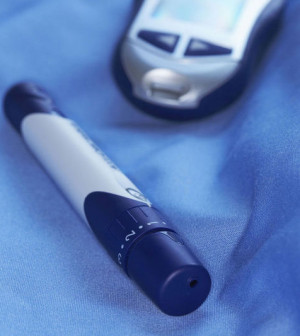- Navigating Your Midlife Crisis: Embracing New Possibilities
- City Raccoons Showing Signs of Domestication
- Mapping the Exposome: Science Broadens Focus to Environmental Disease Triggers
- One Week Less on Social Media Linked to Better Mental Health
- Your Brain Changes in Stages as You Age, Study Finds
- Some Suicide Victims Show No Typical Warning Signs, Study Finds
- ByHeart Formula Faces Lawsuits After Babies Sickened With Botulism
- Switch to Vegan Diet Could Cut Your Greenhouse Gas Emissions in Half
- Regular Bedtime Does Wonders for Blood Pressure
- Dining Alone Could Mean Worse Nutrition for Seniors
Insured Americans Up to 3 Times Likelier to Get Preventive Care: CDC


Americans are up to three times more likely to receive preventive care for potentially fatal chronic diseases if they have health insurance, federal officials reported Thursday.
Insurance provided across-the-board improvement in the number of people receiving any one of nine important clinical preventive services, researchers from the U.S. Centers for Disease Control and Prevention found.
The type of health insurance doesn’t matter. People paying for private insurance received the same preventive care as people on Medicaid or Medicare, according to the findings published in the CDC’s July 17 Morbidity and Mortality Weekly Report.
“Having insurance was the most important factor, whether it was private or public insurance,” said lead author Jared Fox, a CDC health scientist.
Preventive care is available for nine of the 10 leading causes of death in the United States, the study authors said in background information. These include heart disease, cancer, stroke, diabetes, suicide, and communicable diseases such as influenza, pneumonia and hepatitis.
These services can help prolong lives by preventing potentially fatal illnesses or catching them early, according to the researchers.
“Preventive screening helps detect diseases at an earlier stage when treatments may not need to be so aggressive for cure,” said Dr. Stephanie Bernik, chief of surgical oncology at Lenox Hill Hospital in New York City.
The Affordable Care Act, sometimes called “Obamacare,” has made it easier for people to receive preventive care, both by making sure people have health coverage and by requiring insurers to provide recommended preventive services free of charge, Fox said.
In this study, the researchers used 2011 and 2012 data from the U.S. National Health Interview Survey to track who had received nine types of preventive care during the previous year. The survey involved more than 67,500 people drawn from a national sample.
The preventive services examined by researchers included blood pressure, diabetes and cholesterol checks; screening for breast, cervical and colon cancer; diet counseling; and vaccination for either hepatitis A or B.
Insurance proved the major factor in determining whether a person had received any of these services. For example, women were 2.5 times more likely to have had a mammogram to detect breast cancer if they were insured. People with health coverage were at least twice as likely to have received diet counseling or a cholesterol and diabetes check.
It also appears that the Affordable Care Act provision that eliminates out-of-pocket costs for preventive care may boost people’s participation in services that are more expensive, Fox said.
For example, people with insurance were three times more likely to have received colon cancer screening than people without coverage.
“Colorectal cancer screening is one of the more expensive services available, so it could be the case that for services like that, it could be that more people will take advantage if they no longer have a co-pay,” Fox said.
Household income also appeared to play a role in whether someone received the preventive care they need, the researchers found.
People making more than 200 percent of the federal poverty level were slightly more likely to have received preventive services. That’s $23,540 or more a year for a single person in 2015, and $48,500 for a family of four.
In the strongest example, women were 43 percent more likely to have received breast cancer screening if they had a higher income.
And higher-income people were about 25 percent more likely to have received cervical or colon cancer screening, or a diabetes or cholesterol check, the findings showed.
Fox expects that as more people receive insurance under the Affordable Care Act, the number who receive the proper preventive services will continue to increase.
“In other insurance expansion situations, people previously uninsured who received insurance coverage were more likely to receive recommended preventive care,” he said.
Fox and Bernik said it’s important for health experts to get the word out to people about which services they should receive.
“Access to health care is an important part of getting people screened, but it is not enough because even people with insurance often fail to undergo recommended screening,” Bernik said. “Education needs to play a large part in ensuring patients are going for screening.”
To that end, the CDC has created an online interactive tool that can help people figure out the preventive services they should receive, based on their age, gender and other factors, Fox said.
“Part of the motivation behind creating this resource is there are so many services that are recommended for people, and sometimes people don’t know to ask for them,” he said.
More information
For more on preventive health services, visit the U.S. Centers for Disease Control and Prevention.
Source: HealthDay
Copyright © 2025 HealthDay. All rights reserved.










